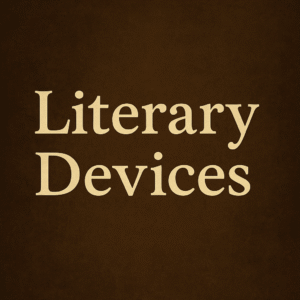Introduction In literature, both symbolism and allegory are powerful tools writers use to add depth to their stories. Although they may seem similar, they are actually quite different in how they work and what they achieve. Understanding the difference between Read More …
Category: Literary Devices

Literary devices help writers shape language in creative, powerful ways. These techniques add meaning, rhythm, emotion, and beauty to any literary work. From poetry to fiction, authors rely on such tools to engage readers and express deeper ideas.
This category on englishlitnotes.com explains key literary devices with clarity and simplicity. Each article uses student-friendly language and includes practical examples from literature. These notes are ideal for learners at every level.
You’ll explore important devices like simile, metaphor, alliteration, imagery, and personification. Each topic offers a brief definition, real examples, and its effect on the reader. These explanations show how style and emotion work together in literature.
Whether you’re preparing for exams, writing essays, or analyzing poems and novels, this section supports your learning. You’ll discover how writers use literary devices to shape tone, mood, and meaning.
Our articles stay focused and easy to follow. We use short sentences, rich examples, and direct tips to help you understand fast. No fluff—just clear, academic support for real results.
This section grows with time. We regularly add new devices, updated examples, and fresh insights to support your studies. Whether you’re a student, teacher, or literature enthusiast, these tools will deepen your reading skills.
englishlitnotes.com makes learning literature feel natural and enjoyable. You can explore, learn, and apply these literary devices confidently.
Bookmark this page and return often. You’ll always find helpful content, expert tips, and clear explanations on literary devices.
Allegory in Literature
Allegory in Literature: A Story Beneath the Story Allegory is one of the most powerful tools in literature. It allows writers to say something important without stating it directly. Through characters, settings, and plots, authors can express deep moral, political, Read More …
Symbolism in Literature: Powerful Images and Hidden Meanings
Introduction: Unlocking Symbolism in LiteratureWriters use symbolism to express complex ideas. They achieve this through objects, characters, or events. Writers use symbolism to give depth to their stories and to suggest themes and emotions without directly stating them. This literary Read More …
Personification in Poetry: Definition and Examples
Personification in Poetry Welcome to this engaging and simple lecture on personification in poetry. This poetic device breathes life into lifeless things. It turns objects, ideas, or animals into characters that feel and act like humans. Writers use it to Read More …
Difference Between Simile and Metaphor – With Clear Examples
Understanding the difference between simile and metaphor helps students analyze literary texts better. Both devices compare two things. However, they do so in different ways. This distinction is important because it adds imagery and clarity to writing. While similes use Read More …
Metaphor in Literature – Definition, Examples, and Complete Guide
What Is a Metaphor?Metaphor is a powerful literary device. It directly compares two different things without using “like” or “as.” Instead of showing similarity, it claims one thing is another. Through this technique, writers create strong images and convey deep Read More …
Simile in Literature with Full Examples and Meaning
Introduction Simile in literature is a powerful literary device that compares two different things using the words “like” or “as.” Writers use similes to create vivid pictures in the reader’s mind. This comparison helps highlight particular qualities in an imaginative Read More …
